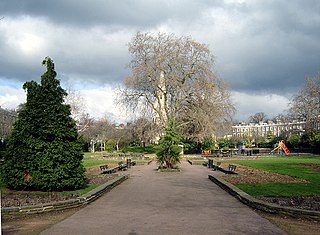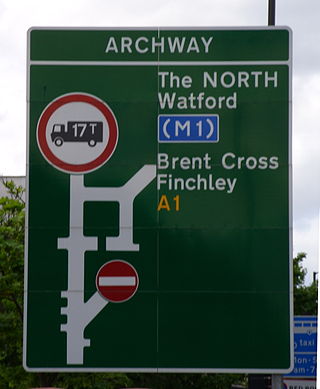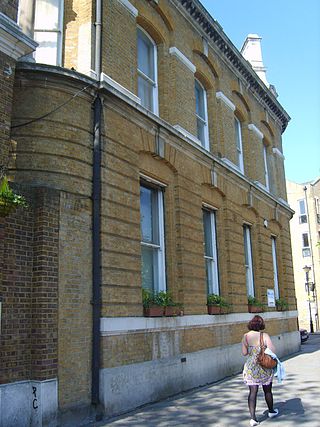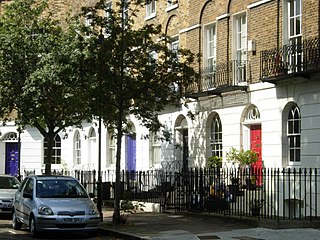
Barnsbury is an area of north London in the London Borough of Islington, within the N1 and N7 postal districts.

Clerkenwell is an area of central London, England.

Holloway is an inner-city district of the London Borough of Islington, 3.3 miles (5.3 km) north of Charing Cross, which follows the line of the Holloway Road (A1). At the centre of Holloway is the Nag's Head commercial area which sits between the more residential Upper Holloway and Lower Holloway neighbourhoods. Holloway has a multicultural population. It is the home of Arsenal F.C., and was once home to the largest women's prison in Europe, Holloway Prison, until 2016. Prior to 1965, Holloway was in the historic county of Middlesex.

Islington is a district in the north of Greater London, England, and part of the London Borough of Islington. It is a mainly residential district of Inner London, extending from Islington's High Street to Highbury Fields, encompassing the area around the busy High Street, Upper Street, Essex Road, and Southgate Road to the east.

Smithfield, properly known as West Smithfield, is a district located in Central London, part of Farringdon Without, the most westerly ward of the City of London, England.

The Angel, Islington, is a historic landmark and a series of buildings that have stood on the corner of Islington High Street and Pentonville Road in Islington, London, England. The land originally belonged to the Clerkenwell Priory and has had various properties built on it since the 16th century. An inn on the site was called the "Angel Inn" by 1614, and the crossing became generally known as "the Angel". The site was bisected by the New Road, which opened in 1756, and properties on the site have been rebuilt several times up to the 20th century. The corner site gave its name to Angel tube station, opened in 1901, and the surrounding Angel area of London.

Sir Horace Jones was an English architect particularly noted for his work as architect and surveyor to the City of London from 1864 until his death. He served as president of the Royal Institute of British Architects from 1882 until 1884, and was knighted in 1886. His most recognised work, Tower Bridge, was completed posthumously.

Billingsgate Fish Market is located in Poplar in London. It is the United Kingdom's largest inland fish market. It takes its name from Billingsgate, a ward in the south-east corner of the City of London, where the riverside market was originally established. In its original location in the 19th century, Billingsgate was the largest fish market in the world.

Liverpool Road is a street in Islington, North London. It covers a distance of 1+1⁄4 miles (2.0 km) between Islington High Street and Holloway Road, running roughly parallel to Upper Street through the area of Barnsbury. It contains several attractive terraces of Georgian houses and Victorian villas, many of which are listed buildings. There are a number of pubs, small businesses and restaurants along its route, as well as some secluded garden squares. The vast majority of the street is residential, with a bustling shopping and business area at the southern, Angel, end.

The London Borough of Islington is short of large parks and open spaces, given its status in recent decades as a desirable place of residence. In fact, Islington has the lowest ratio of open space to built-up areas of any London borough. The largest continuous open space in the borough, at 11.75 hectares, is Highbury Fields.

Market Estate is a public housing estate consisting of 271 flats and maisonettes situated to the north of Caledonian Park in the London Borough of Islington. It is named after the Metropolitan Cattle Market which operated on the site until the 1960s. After slaughter the carcasses of cattle and sheep were sent by underground trains to Smithfield Market to be traded. Three of the six blocks that make up the estate are named after breeds of animal that were traded in the market: Tamworth (pigs), Kerry (cows) and Southdown (sheep). The remaining three blocks are called the Clock tower blocks after the market's clock tower which still stands in Caledonian Park. This contains a working clock used as a prototype for the mechanism of Big Ben.

Lonsdale Square is a garden square in the Barnsbury district of Islington, North London. It is bounded by unusual Tudor Gothic Revival terraced houses, with picturesque gables and Elizabethan-style windows, and is probably unique among squares. All the houses are listed buildings. The central public garden contains flower beds and mature trees.

The A1 in London is the southern part of the A1 road. It starts at Aldersgate in the City of London, passing through the capital to Borehamwood on the northern fringe of Greater London, before continuing to Edinburgh. The road travels through the City and three London boroughs: Islington, Haringey and Barnet, which include the districts of Islington, Holloway, Highgate, Hendon and Mill Hill, and travels along Upper Street and Holloway Road, crossing the North Circular Road in Hendon, a district in the London Borough of Barnet.

Charrington Brewery was founded in Bethnal Green, London, in the early 18th century by Robert Westfield. In 1766, John Charrington joined the company, which then traded as Westfield, Moss & Charrington from the Anchor Brewery in Stepney. It merged with United Breweries of London in 1964, and with Bass Brewery in 1967 to become the largest UK brewing company, Bass Charrington. The brewing operations of the company were bought by Interbrew in 2000, while the retail side were renamed Six Continents. In 2003, Six Continents split into a pubs business, now known as Mitchells & Butlers, and a hotels and soft drinks business, now known as InterContinental Hotels Group.

Caledonian Road passes for about a mile and a half north–south through the London Borough of Islington. It connects North London, from Camden Road near its junction with Holloway Road, and central London's Pentonville Road in the south. It is known colloquially as the "Cally" and forms the entirety of the A5203.

The recorded history of Wetherby, a market town in the City of Leeds metropolitan borough, West Yorkshire, England, began in the 12th and 13th centuries when the Knights Templar and later the Knights Hospitallers were granted land and properties in Yorkshire. The preceptory founded in 1217 was at Ribston Park. In 1240 the Knights Templar were granted by Royal Charter of Henry III the right to hold a market in Wetherby. The charter stated the market should be held on Thursdays and an annual fair was permitted lasting three days over the day of St James the Apostle.

Columbia Road Flower Market is a street market in Bethnal Green in London, England. Columbia Road is a road of Victorian shops situated off Hackney Road in the London Borough of Tower Hamlets. The market is open on Sundays only.

James Bunstone Bunning was an English architect. He held the post of architect to the City of London from 1843 until his death, and is probably best remembered for his design for the Coal Exchange.

The Caledonian Park Clock Tower, Islington, London, is the major remaining element of the Metropolitan Cattle Market, opened in 1855 by the City of London Corporation as a replacement for the market at Smithfield. The complex was designed by the Corporation's Surveyor, James Bunstone Bunning, and was laid out on a site of 30 acres (0.12 km2) that originally formed the estate of a mansion, Copenhagen House. The market consisted of the central clock tower, enclosures for animals, slaughterhouses, sales arenas, administrative offices and four public houses, one standing at each corner of the complex. The cattle market was closed in the 1930s, and the meat market in the 1960s, with much of the site being redeveloped for council housing. The clock tower, two stretches of railings and three of the four pubs are all that now remain. After suffering neglect and vandalism in the late 20th century, the clock tower was restored between 2016 and 2019 and is now open to the public. It is a Grade II* listed building, the railings and pubs having separate Grade II listings.

Cloudesley Square is a square in the Barnsbury district of Islington, North London. It is bounded by Georgian terraced houses, all of which are listed buildings. The central area is occupied by the Gothic Revival former Holy Trinity Church, designed by Charles Barry.
























